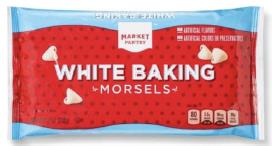Salazar v. Target Corp., 2022 WL 4298521, --- Cal.Rptr.3d ----, 2022 WL 4298521, No. E076001 (Ct. App. Sept. 19, 2022)
First of two white chocolate cases; unlike federal courts
(and the court below), the court of appeals says that consumers were plausibly
misled about whether Target’s White Baking Morsels contained white chocolate.
The court of appeals found that a key fact was that the White Baking Morsels’
price tag describes them as “WHT CHOCO,” which could lead a reasonable consumer
to reasonably believe that they contain white chocolate.

shelf, kind of unreadable 
white baking morsels package
Salazar thought the White Baking
Morsels contain white chocolate because (1) their label describes them as
“white,” (2) their price tag says, ‘ “MP WHT CHOCO,’ ” (3) their label depicts
the product, which look like white chocolate chips, and (4) the product is sold
next to other chocolate products.
He brought the usual statutory claims. He also alleged that
the results of a survey show that 88 percent of consumers are deceived by the
White Baking Morsels’ advertising and incorrectly believe they contain white
chocolate.
The court of appeals did reject his website allegations (that
Target falsely advertises on its website that the “ ‘chocolate type’ ” of White
Baking Morsels is “ ‘white chocolate,’ ” and places the product in the “
‘Baking Chocolate & Cocoa’ ” category) because he didn’t see and therefore
didn’t rely on the website.
By its plain terms, “WHT CHOCO”
suggests precisely what Salazar alleges: that the White Baking Morsels contain
white chocolate. At a minimum, a reasonable consumer could be confused about
whether the morsels are made with white chocolate given the price tag’s
description of the morsels as “WHT CHOCO” and the fact that the product’s label
does not clearly state whether they contain white chocolate.
More significantly, “[e]ven without the price tag, a
reasonable consumer could be misled by the White Baking Morsels’ label into
believing that they contain white chocolate. A reasonable consumer might know
there are white chocolate chips used for baking while not knowing that
white-colored baking chips that do not contain white chocolate exist.”
Other cases relying on the dictionary definition of “white” were
not persuasive; context can change meaning, so “white” “can sometimes describe
the quality of the food, not just its color.” The packaging as a whole also
contained “a picture of what appears to be a white-colored chocolate chip,” and
Salazar also alleged that Target’s placement of the chips near other
real-chocolate-containing chips was misleading.
Although there were no explicitly false representations about white chocolate, literally true statements “ ‘ “couched in such a manner that [are] likely to mislead or deceive the consumer ... [are] actionable.” ’ ” Indeed, “[d]eceptive advertisements often intentionally use ambiguity to mislead consumers while maintaining some level of deniability about the intended meaning.” California law doesn’t require reasonable consumers “ ‘to look beyond misleading representations on the front of [a product] to discover the truth from the ingredient list in small print on the [back of a product]’.... ‘The ingredient list must confirm the expectations raised on the front [of the product], not contradict them.’” Given that the ingredient list conflicted with the price tag’s “WHT CHOCO,” Salazar’s claims were plausible.
Salazar v. Walmart, Inc., 2022 WL 4299338, -- Cal. Reptr. 3d
---, No. E076006 (Ct. App. Sept. 19, 2022)
Same thing for Walmart. This time there is no “WHT CHOCO”
price tag but the result is still the same, given the other contextual factors
(the “white” in the product’s name, the label’s depiction of the product, and the
fact that it is sold near other chocolate products) plus Salazar’s survey.
 |
| worse quality picture but you get the idea |






No comments:
Post a Comment